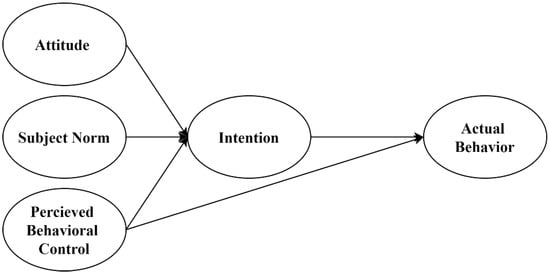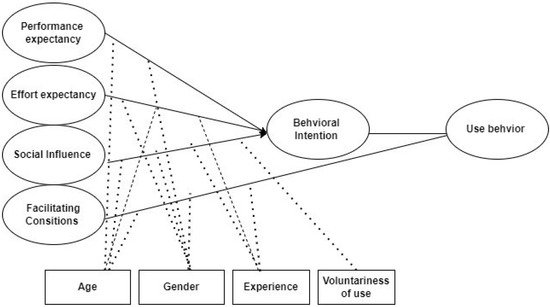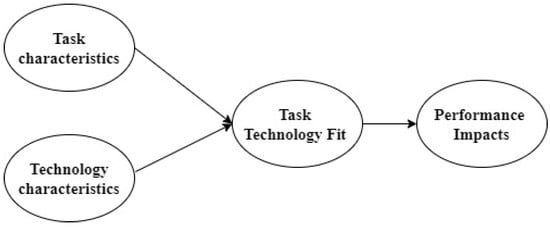Due to the rapid growth of Massive Online Open Courses (MOOCs), higher educational institutions across the world are investing heavily in MOOCs to support their traditional teaching, their students’ learning experience, and their performance. User’s perception (PE, EE, ATT, TAC, and TEC) can positively influence BI’s willingness to use MOOCs.
1. Introduction
For several years, higher education institutions (HEIs) have been under pressure to innovate due to two external forces: the need to reduce costs, while addressing the rising demand for higher education (HE); the need to demonstrate the relevance of their degree programs for employability in the ever-changing world [
1]. Massive Online Open Courses (MOOCs) were introduced as the next big thing in HE and branded as the tool for ‘innovative disruption’ that will improve education [
2]. This system—which alters remote education delivery and increases students’ and scholars’ access to open educational resources (OER)—has attracted over 800 colleges and universities that offer thousands of these courses to millions of registered individuals worldwide [
3]. These numbers have positioned MOOCs as strong virtual platforms for education, and as a result, many HEIs are pioneering various initiatives to incorporate MOOCs into their teaching and learning activities. Despite the growing popularity of these courses in HE, understanding students’ and scholars’ acceptance of such courses is crucial to their success.
Existing studies have explained MOOCs’ user acceptance in the HE context using a multitude of human behavior theories, e.g., [
4]. Among these, the Theory of Planned Behavior (TPB) [
5], as well as the Unified Theory of Acceptance and Use of Technology (UTAUT), were some of the most frequently applied. TPB was developed to describe generic human behavior, whereas UTAUT was designed to explain specific MOOC user adoption. These theories describe several elements that impact a technology’s adoption, with behavioral intention (BI) (to intend to use the technology) and actual behavior (real usage of the technology) serving as indicators of acceptance. However, concentrating exclusively on users’ impressions of technology may be insufficient. According to the Task-Technology Fit (TTF) model, users will accept a technology if its qualities match the task requirements [
6]. While users may acknowledge technological advancements, they may not utilize them if they believe such technologies are unsuitable for their activities or they do not increase users’ work efficiency [
7]. Users are utilitarian individuals, whose usage of technology is based not only on perceptions and attitudes but also on a strong TTF.
Numerous scholars have conducted additional research on frameworks that incorporate at least one of these models, in the empirical literature, with regards to the persistence in using these courses in HE [
8]. Several research works have compared TTF with the technology acceptance model (TAM) to predict learners’ desire to continue using these courses, while others merged TTF and UTAUT models to provide an enhanced MOOCs adoption model, e.g., [
9].
Theory of Planned Behavior (TPB)
The TPB [
18], derived from social psychology, is a forerunner to other models, and it is frequently used as an explanation of behavior and for understanding technology usage and its adoption [
19]. As illustrated in
Figure 1, the TPB states that user behavior is dictated by their perception of control, while their intention is affected by their attitude on behavior (ATT), subjective norms (SN), and perceptions of behavioral control (PBC) [
5]. Additionally, some scholars have provided empirical support for TPB in their research on MOOCs [
20].
Figure 1. Theory of Planned Behavior.
The Unified Theory of Acceptance and Use of Technology (UTAUT)
The UTAUT [
19] is based on eight theories and models: namely, the technology acceptance model (TAM), the theory of reasoned action (TRA), the motivational model (MM), the TPB, the combined TAM TPB model (C-TAM-TPB), the model of PC utilization (MPCU), the innovation diffusion theory (IDT), and the social cognitive theory (SCT). Although UTAUT is not as widely used as TAM, it has garnered academic interest in recent years for its ability to determine user acceptance of MOOCs [
21], as demonstrated in
Figure 2. According to Venkatesh [
19], the eight models explain between 17% and 53% of the variance in users’ intentions to use information systems (ISs)/information technology (IT). UTAUT, on the other hand, outperformed all eight models tested on the same data, accounting for more than 70% of the variance in BI and 50% in technology use [
19,
22]. Venkatesh [
19] proposed that, when researchers are confronted with a significant number of identical constructs provided by many theories, they either “pick and choose” constructs from the models or choose a “preferred model”, whilst ignoring the others. For these reasons, UTAUT can contribute to the understanding of the elements that influence users’ adoption of MOOCs.
Figure 2. UTAUT Model.
Task-Technology Fit (TTF)
The TTF model is currently being explored and used with a range of ISs [
23]. It (
Figure 3) considers technology as a beneficial instrument for enhancing individual performance and can be used if its capabilities fit the tasks that users must perform [
24]. According to Wu and Chen [
25], TTF is a widely used model for assessing how IT affects user performance by correlating task characteristics (TAC) and technology characteristics (TEC). Both these factors have an impact on TTF, which, in turn, defines user performance. The TTF model is the primary subject of interest of this research. According to the TTF model, a user accepts an IT system only if it is a good fit for the activities at hand and increases efficiency [
6]. TTF has been broadly used and integrated with related models, such as UTAUT, to investigate the adoption of IT systems since their debut, e.g., [
26].
Figure 3. The Task-Technology Fit Model.
2. Factors in MOOCs Adoption in Higher Education
The MASEM approach is a method for analyzing quantitative data. It was used to incorporate the UTAUT, TTF, and TPB, in terms of their abilities, to investigate MOOCs’ adoption in HE.
It was discovered that PE and EE have substantial effects on BI, which is consistent with earlier UTAUT bodies of research [90,100]. However, this is inconsistent with an earlier report, which indicates that PE and EE have a non-significant effect on BI [101]. More precisely, this study established that PE is involved in the formation of BI (H1). This means that users will be more receptive to MOOCs if they believe that technology could enhance teaching and learning. It was also discovered that EE has a role in explaining BI in the context of MOOCs (H2). This implies that the easier it is for a MOOC service to learn and perform MOOCs-related tasks, the greater the proclivity to engage in the technology. In a similar way, this MASEM analysis has established that ATT is a critical variable for BI reinforcement (H6). This concurs with a previous study on university students’ intentions towards the usage of a cloud computing classroom, e.g., [100]. As a result, if an individual had a positive ATT about using MOOCs platforms, a high degree of adoption intention is formed. These MASEM findings demonstrate that, while analyzing the factors affecting MOOC users’ uptake, the UTAUT-based technology perceptions must not be considered in isolation but, rather, have to also take into account the impact of the TTF. Additionally, the findings indicated that TAC and TEC were both significant predictors of TTF, with technology attributes having a greater effect [102,103].
It is possible that the effect of SN, within a given culture, differs from country to country, rendering the effect of SN on intention to use MOOCs contextually different. The finding might also reflect learners’ and educators’ uncertainty regarding the availability of various software or hardware conditions that enable them to use MOOCs. Furthermore, two new pathways emerged from the analysis: namely, the TAC and TEC. These two had direct effects on the BI to continue to use MOOCs. It is proposed that the nature of the tasks performed by the users will dictate whether MOOCs are beneficial. D’Ambra [104], Dishaw and Strong [26], as well as Koo [105] discovered strong associations between TAC and technology use. The variable TAC was chosen as a factor that would potentially influence consumers’ utilization of MOOCs, based on the results of the MASEM analysis. Additionally, this study has established a positive relationship between TEC and user’s utilization of MOOCs. TEC reflects the characteristics of MOOCs that are relevant for task completion. TEC has been shown to influence a system’s usefulness, ease of learning, accuracy, adaptability, and dependability [106]. Integrating TEC with task characteristics can aid in determining the technology’s best fit for the activity. D’Ambra [104], Hollingsworth [107], as well as Koo [105] have discovered that substantial correlations exist between TEC and technology adoption.
The moderator analysis supported the variance effects of the integrated framework’s constructs on the actual MOOCs usage. The analysis of the type of sample size—acting as a moderator—offers insight into the effect sizes and resultant findings. Age was identified as a significant moderating role in a user’s decision to use ICT [19,22]. Despite being the primary predictor across all age brackets, the SI and ATT appeared to have greater effects on youths than on adults. The other predictors exhibited an opposite pattern. Gender has been extensively researched as a key demographic factor influencing ICT adoption [19,22]. Additionally, the findings revealed that ATT is more predictive of females than of males. Our findings corroborate prior research on the impact of age and gender on technology acceptance [108,109].
This entry is adapted from the peer-reviewed paper 10.3390/su14148268



